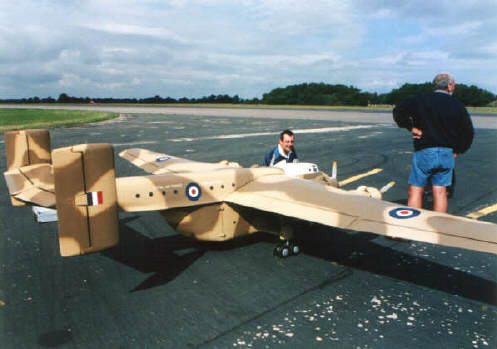The Blackburn Beverley was a heavy-lift transport aircraft which served with the RAF between 1956 and 1967. Only 47 Beverleys were built, but they were kept busy in many countries including Aden, Brunei, Keyna, Sarawak and Zanzibar. They were built at Brough, East Yorkshire.
The Beverley design was based on the the tank carrying General Aircraft Hamicar glider which gave much service during WWII. Many people thought the Beverley to be ugly, slow and cumbersome, but the aircraft had a very useful role in transporting supplies. The clamshell doors could be removed to enable supply dropping. Thirty six people could be carried making it suitable for use by paratroupers. Another important feature was that the propellers had a reverse pitch feature to enable short landings and it could even reverse.

Gordon built the model in 1999. The aircraft is rarely modelled in a large scale and this meant that obtaining accurate three view drawings was a problem. Dave Boddington came to Gordon’s rescue and lent him one from his massive collection of drawings, plans and photographs
The wing construction was based on foam wings covered with obechie veneer with spruce spars. The various ‘holes’ and load bearing surfaces were reinforced using a combination of pine and balsa.
High grade plywood was used in the basic engine nacelles and the curved final shape was produced with blue foam.
The wing housed two aileron servos, four flap servos and four engine servos.
The fuselage was quite simple to construct from blasa, ply wood and spruce. The curved front and rear were again formed from blue foam.
The tailplane, elevator and fins were also conventionally built.
The construction was finished with glass cloth prior to a sprayed finish.
Zenoah 38 engines were fitted with aluminium elbows to make the carburetors rear facing.
Ten 8in wheels were supplied by Len Gardiner. The fully sprung scale undercarriage was built with the help of Neil Dance.

The first flight was made Easter 1999. There was considerable difficulty getting the model to fly straight and level. The tailplane incidence was 5.5 degrees and it had to be swung around to solve the problem.
The model had two minor mishaps in its life of several hundred flights. The first was due to a transmitter failure that initially appeared to result in the total destruction of the aircraft. However, with the help of Lance Bell, Gordon spent many nights ‘burning the midnight oil’ to get the model ready to fly a few weeks later. Its second mishap was at the Catton Hall show in 2002. Here the aircraft appeared to be suffering from a loss of power due to hot weather. It struggled to get over some trees and finally crashed ending its life on the show circuit.

Gordon is seen here preparing the aircraft for flight.
For event tickets, merchandise and more visit our online shop.